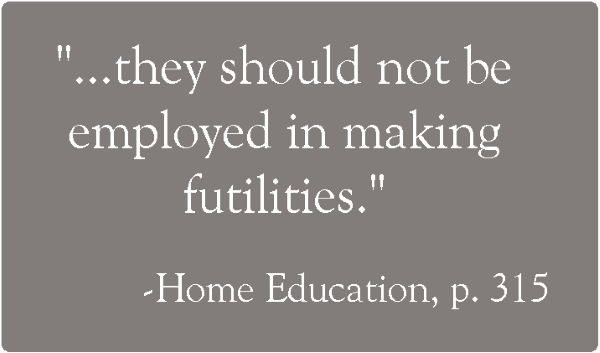
Listen Now:
“Points to be borne in mind in children’s handicrafts are: a) that they should not be employed in making futilities such as pea and stick work, paper-mats and the like; b) that they should be taught slowly and carefully what they should do; c) that slipshod work should not be allowed; d) and, that, therefore, the children’s work should be kept well within their compass.” (Vol. 1, pp. 315-316)
“Small children finish anything set for them to do alone very quickly as a rule, and I find it a great help if they can have some easy handicraft to be picked up in spare moments.” (Parents’ Review, “Notes and Queries”, Vol. 44, p. 480)
If you would like to study along with us, here are some passages from The Home Education Series and other Parent’s Review articles that would be helpful for this episode’s topic. You may also read the series online here, or get the free Kindle version from Fisher Academy.
Home Education (Volume 1), Part V, Chapter XXI
School Education (Volume 3), pp. 355-359
Paper Sloyd for Primary Grades
(Contains affiliate link)






While listening to this podcast I was reminded of our visit to Greenfield Village in Dearborn, MI this past summer. They have on display the house that Orville and Wilbur Wright grew up in as well as their bicycle shop from Dayton, OH. While visiting their childhood home my initial thought was wow, they were quite wealthy people. Then the museum volunteer gave a talk on their childhood and said that their mother taught them at home. Her plan was to have them read a ton of great books and she also taught them crafts. She taught them sewing skills which they later used in making their first airplane. She also taught them woodworking. The volunteer explained that they were not a wealthy family at all but the boys created beautiful intricate designs in the door frames and window sills, they also created an amazing stair case in their home and porch railing and detail work outside the home. It once again solidified our decision to adopt a CM way of education. And my 12 year old son has learned to enjoy sewing but he said he gets teased by some friends. So I told him to tell them about the Wright brothers and how their skill with the needle and an understanding of how selvages work enabled them to create the first airplane.
Valerie,
Those are good examples of how handicrafts breed ideas and service. You could comfort your son that, some day, he may be able to help his teasing friends when they rip their clothing out. My husband's grandmother taught him to darn socks and he is one who does not throw them out just because they get a hole.
Liz
Thanks so much for this! Is Origami considered the same as Paper Sloyd? My daughter has fallen in love with origami, so I hope so 🙂
Oregami is the Japanese art of folding paper into decorative objects. Sloyd is a handicraft developed in Finland that also involves folding of paper, but produces useful products, such as envelopes, baskets, sheaths, etc. It is valuable, as is Oregami, for following directions, but does include rulers, pencils, and scissors in producing the object.
-Liz
My son learned to knit one winter as a young teen because he was laid up after a foot injury for several weeks. As a college student he impressed several girls by his knitting skills when he picked up a girls project and started knitting. His impromptu knitting could have backfired on him! Instead it was one more surprising skill his friends discovered he had.
Thanks for sharing. As we are always reminding: we never know when, where, how, or what in the feast God will use in the children’s future.
-Liz